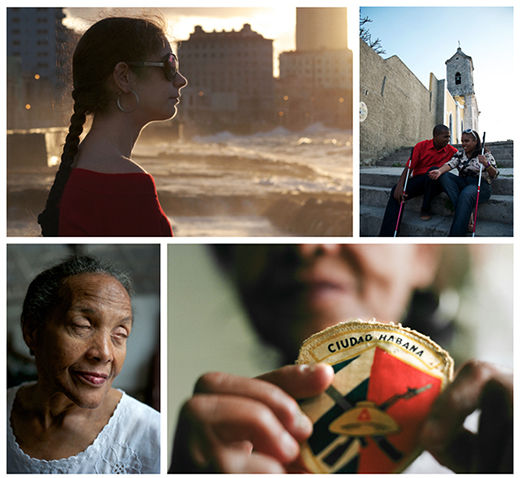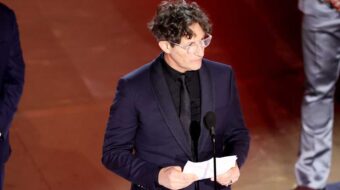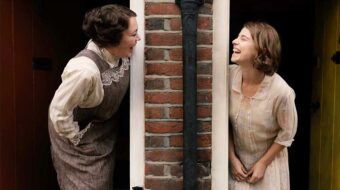
DURHAM, N.C. – Let’s begin our review of the 18th year of Full Frame, a documentary film festival held annually in Durham, N.C., with 3.5 warm human interest stories.
Full Frame offers a full plate of, shall we say, heavy fare: Very serious issues not ordinarily treated with a light touch. But a filmgoer simply has to relieve the load with some intimacy and humor.
As someone who has visited Cuba repeatedly, I was drawn to the world premiere screening of Tocando la luz (Touch the Light), an American production set in Havana that was filmed over a period of three years. Filmmakers Jennifer Redfearn (director) and her co-producer Tim Metzger, who also served as cinematographer, went to Cuba seeking out a fresh way to talk about the island country without the usual musical or political angle. One day they were introduced to a unique place: a movie theater with special film showings for the blind, where a live raconteur reads a narration in between the dialogue, telling the audience what they need to know about what is happening on-screen. Intrigued by this program, they went on to discover other services for the blind in Cuba, and decided to focus their feature on three sightless women in Havana, their backstories, families and communities, their challenges, aspirations and lives.
Anyone familiar with the world of the blind, and with life with a disability, knows that just about everyone seeks to gain as much independence as they can manage. The film focuses closely on the personal lives of its protagonists, showing the degree of support they get from relations and friends. If beyond that the intention of the film was also to show that Cuba has generous programs and policies in place to help her blind citizens, the point is made subtly and incrementally.
First we meet Margarita, a charming black lady in her 60s who well remembers the Revolution from her early childhood. Although she lost her vision completely before reaching the age of ten, she volunteered to serve in a blind militia corps for the defense of the Revolution, and remains forever proud of her training, her uniform and epaulets, which she guards protectively. Her husband has been dead for half a dozen years now, and is much missed. Although his story is not shown in any detail, they married despite her disability, and they were apparently very deeply in love. Margarita has an active circle of friends, neighbors, and fellow blind people, as well as a paid helper/companion. Understandably she has trouble letting go of possessions – and the sweet memories associated with them – if she’s to move on in life.
Mily is up next, a vivacious 25-year-old, also black, still living at home with her parents, whom she loves, but also resents for their overprotection from life’s vicissitudes. She has a boyfriend, also blind, who gently encourages her to stretch and make more of herself. He struck me as kind, clear-thinking, rational and optimistic, the very model of a modern Cuban man. She is shown, with some co-workers, at a worksite where blind people are employed in the more or less “make work” job of folding and stacking envelopes, which neither requires nor advances any skills – one of the few sour notes struck in the film. Her challenge will be to recreate her life as an adult with dreams of a home of her own and possibly children.
Finally we have Lis, who is almost wholly reliant on her mother, for she has never cared to learn how to use a cane to get around; and curiously, the mother (and grandmother) are also reliant on her. Lis is a talented singer who appears at shows, and even an international competition, so her earnings constitute the better part of the family income. But what will happen if and when her mother is no longer around? I found it very interesting – and surely the filmmakers did as well – that it was this family, Caucasian, that for at least three generations has embraced santería as their religion. A goat has a brief but poignant cameo role.
This film’s first-time director won the festival’s Charles E. Guggenheim Emerging Artist Award. Editor David Teague deserves a shoutout for his fluid meshing of three disparate lives that do not intersect as such, but nevertheless all comment on each other.
And the Audience Award goes to…
The Audience Award for Feature Film went to director Alexandra Shiva’s How to Dance in Ohio, which documents a few months in the lives of students at a learning center for people on the autism spectrum in Columbus, Ohio. As in Tocando, the focus is again on three young women, Marideth, Caroline and Jessica, who are honing their social and communication skills preparing to attend a formal prom complete with gowns, elegant hair stylings, corsages, dancing and dates, with crowds of jostling people and booming music. Its similarity with the Cuban film is precisely in the search for independence while managing a powerful disability.
An important character in How to Dance is the ebullient Dr. Emilio Amigo, the clinical psychologist who patiently works with his autistic clients in his well-appointed center to achieve measurable – and in some cases almost miraculous – results. There’s a poster in his office that reads, “Life begins at the end of your comfort zone,” a reminder to just about anyone that we are all trying to cope with the hand we were dealt. It may sound ungenerous of me, but I could not help feeling that in a big way the film was kind of an “advertorial” for Dr. Amigo’s center. Still, he does impressive, caring work, and I suspect that the film will go a long way toward humanizing people with autism and suggesting ways their friends, families and communities can gain more understanding.
The .5 film among the 3.5 I mentioned above is a Dutch item directed by Astrid Bussink lasting 18 minutes, called Giovanni and the Water Ballet, which won the Audience Award for Best Short Film. It’s about a 10-year-old boy who dreams of competing in the Dutch synchronized swimming championship, and is the only boy in the pool. It makes a gentle but firm case against stereotyping and encourages us to give kids the freedom of their choices.
A man and his horse
The third full-length feature reviewed here is the world premiere showing of Harry & Snowman, directed by Ron Davis, about a man and his horse. Because of its subject matter I was frankly not prepared to love it, but I did. Which proves once again the wisdom of stepping outside your comfort zone.
Harry deLeyer emigrated from Holland to the U.S. after WWII: In a brief passage he discusses his exploits as a teenager during the German occupation of Holland as a courier for the resistance. But what he always loved and wanted most was continuing employment with horses, and when he and his wife started a good Catholic family of eight kids, all were involved in the horse business. Harry taught riding, both at an elite private school for girls on Long Island, and then at his own stables and riding academy. His own kids’ prowess was his best advertisement for the school.
Searching for a slow, working animal that would be good for beginners, Harry purchased Snowman at an auction in Pennsylvania for $80, rescuing the animal from the dogfood – or the glue – factory. As he befriended the horse and started training him to work with his student riders, he slowly began to appreciate that Snowman was capable of much, much more.
Cutting to the chase, Snowman became the most award-winning show horse of his day, winning national championships two years in a row at the most prestigious shows in Madison Square Garden in the late 1950s. After more than half a century, Snowman still holds the American record for the high jump.
His remarkable rise – he was called “the eighty-dollar champion” and “the Cinderella horse” – closely paralleled Harry’s own ascent, from penniless immigrant to world-class trainer and rider, in a sport that flagrantly celebrated wealth, class and privilege. Equestrian fans of the lowest social orders could look to this stunning example of success against all odds, and hold it up as an inspiration. Taxi drivers were quoted saying, “There’s even a chance for a little guy like me.”
The day came when Snowman had to retire. He was paraded around Madison Square Garden in a final viewing before his adoring public as “Auld Lang Syne” played. TV news coverage at the time reported that there was “not a dry eye in the house,” and by this time I was so hooked on the story that I sat there with a tear in my own eye. It felt good to be reminded of my own vulnerability to sentiment.
Full Frame is sponsored by the Center for Documentary Studies at Duke University. The festival took place April 9-12 this year, in and around the Durham Convention Center, the next-door Carolina Theatre, and a few other neighboring venues. It’s all very walkable and well organized. It is recognized as the premier locale for documentaries, and attracts both a national and international following, as well as a loyal cohort of local supporters and attendees.
These films are just beginning their public life, so it may be some months before they finish their tour of the festivals and get picked up for national distribution. Be on the lookout. Watch People’s World for upcoming reviews on more documentaries at Full Frame about environmental issues, global policy, and law enforcement.











Comments